The points of similarity between Loeben’s ballad and saga and the ballads and MAerchen of Brentano, all of which Loeben knew in 1821, are wholly negligible. It remains,[91] therefore, simply to point out some of the peculiarities of Brentano’s “Loreley” as protrayed in the RheinmAerchen—peculiarities that are interesting in themselves and that may have played a part in the development of the legend since 1846.
In “Das MAerchen von dem Rhein und dem MUeller Radlauf,"[92] Loreley is portrayed in a sevenfold capacity, as it were: seven archways lead to seven doors that open onto seven stairways that lead to a large hall in which Frau Lureley sits on a sevenfold throne with seven crowns upon her head and her seven daughters around her. This makes interesting reading for children, but Brentano did not lose sight of adults, including those who like to speculate as to the origin of the legend. He says: “Sie [Lorelei] ist eine Tochter der Phantasie, welches eine berUehmte Eigenschaft ist, die bei Erschaffung der Welt mitarbeitete und das Allerbeste dabei that; als sie unter der Arbeit ein schOenes Lied sang, hOerte sie es immer wiederholen und fand endlich den Wiederhall, einen schOenen JUengling in einem Felsen sitzen, mit dem sie sich verheiratete und mit ihm die Frau Lureley erzeugte; sie hatten auch noch viele andere Kinder, zum Beispiel: die Echo, den Akkord, den Reim, deren Nachkommen sich noch auf der Welt herumtreiben.”
Just as Frau Lureley closes the first MAerchen, so does she begin the second: “Von dem Hause Staarenberg und den Ahnen des MUellers Radlauf."[93] Here she creates, or motivates, the other characters. Her seven daughters appear with her, as follows: Herzeleid, Liebesleid, Liebeseid, Liebesneid, Liebesfreud, Reu und Leid, and Mildigkeit. She reappears then with her seven daughters at the close of the MAerchen, and each sings a beautiful song, while Frau Lureley, the mother of Radlauf, proves to be a most beneficent creature. Imaginative as Brentano was, he rarely rose to such heights as in this and the next, “MAerchen vom Murmelthier,"[94] in which Frau Lureley continues her great work of love and kindness. She rights all wrongs, rewards the just, corrects the unjust, and leads a most remarkable life whether among the poor on land or in her element in the water. All of which is poles removed from Loeben’s saga, though he knew these MAerchen,[95] for they were written when Brentano was his intimate friend.
As to the importance of Loeben’s saga, Wilhelm Hertz says: “Fast alle jUengeren Dichter knUepfen an seinen Erfindungen an, so besonders die zahlreichen musikdramatischen Bearbeitungen."[96] It is extremely doubtful that this statement is correct. It is plain that many of the lyric writers leaned on Schreiber, and the librettists could have done the same; or they could have derived their initial suggestion in more attractive form than that offered by Loeben. It seems, however, that Geibel[97]




